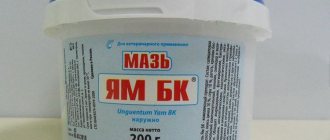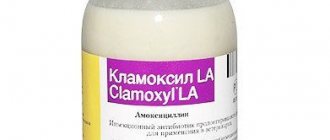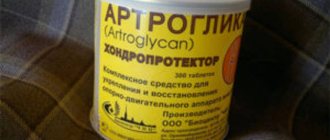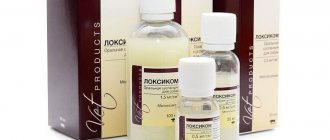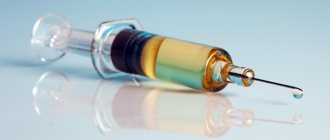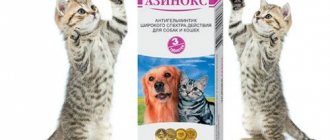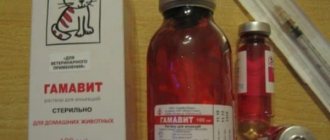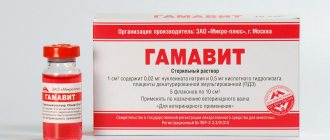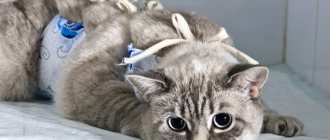It is necessary to approach the care of pets with special responsibility. Therefore, if there are any symptoms of disease, it is very important to promptly treat your pet. So, for example, lichen (dermatophysus), known to many, is very dangerous and contagious. An excellent remedy for combating it can be the drug “Polivak-TM”. This vaccine is only suitable for the cat family.
Polivac vaccine for cats instructions for use
This drug is used for the prevention and treatment of lichen in both cats and dogs.
The most interesting thing is that the drug should be administered to kittens for the first time at the age of 1-5 months. After 2 weeks, revaccination is carried out. The vaccine helps prevent the development of lichen. It is caused by microscopic creatures – dermatomycete fungi. Their two main species are Microsporum canis and Trichophyton mentagrophytes. Causes of lichen in cats:
- Contact with infected animals. This is a contact disease that is transmitted by contact of fungal spores with the fur.
- Weakened immunity. Lichen spores live for a long time on bedding, combs and even in the soil. Therefore, a cat may not have contact with a sick animal, but will still get sick if it picks up an infection on the street.
- Failure to comply with hygiene rules by the owners. This happens when owners use the same brushes or bowls on different cats. Ringworm is often acquired in the hospital.
- The disease is in the past. Mushrooms can live for about 2 years. After contact with the skin, itching and flaking occur. Fungi grow on your pet, forming bald spots.
Polivac vaccine for cats: instructions for use
Instructions for use:
- The vaccine is sold in ampoules or disposable syringes with a certain amount of the substance.
- It is necessary to lay the kitten on its stomach, and leave its hind legs tucked under itself. After this, the skin area is disinfected with 70% alcohol or another antiseptic.
- After this, 1 ml of the drug or whatever is in the syringe is injected. After this, the wound is again treated with an antiseptic.
- The place for administering the drug should be the animal's thigh. There is a lot of muscle tissue in this part.
- After administration of the drug, vaccination must be repeated 7-15 days later. The course consists of 2 injections.
- The effect is achieved a month after administration of the first part of the drug. It is after a month that antibodies are produced.
- Vaccination is carried out once a year. To treat lichen, the amount of the drug is increased and administered according to a different scheme.
Polivac vaccine for cats: instructions for use
Instructions for use
Blokhnet for cats: drops, instructions
Cats are susceptible to fungal diseases more often than other pets. High vulnerability leads to infection of individuals who never walk outside.
Vaccine
The disease is equally dangerous for both cats and their owners. Children are at increased risk of accidental illness, as they are most likely to come into contact with pets.
For treatment
The standard course of therapy involves two injections. In case of severe fungal infection, the medication is administered up to four times. The break between injections is two weeks.
For prevention
To prevent infection with lichen, double manipulation is carried out, the interval between injections is two weeks. The procedure is carried out every year, only healthy individuals can be pierced, without signs of malaise or fever.
Side effects
Testing of the drug showed that there were no side effects for cats after administration of the drug. In some animals, mild swelling and inflammation occur at the site of administration of the substance. Even without additional care in the form of emollients, everything will go away in a few days.
Read the instructions before use
If vaccination coincides with the incubation period of the disease, vaccination will lead to an accelerated manifestation of dermatomycosis. Many foci of the disease will appear on the cat’s body. In this case, it is recommended to administer the drug as treatment with an appropriate dosage.
If a severe form of the disease is observed, injections of the drug are performed 3-4 times with an interval of 2 weeks.
Analogues of the drug
Inexpensive substitutes for the main drug include microderm and vakderm. Both medications are injected according to a similar scheme: twice with an interval of 14 days. Prevention of dermatomycosis is carried out:
- for young animals from 1 to 3 months - 0.5 ml;
- older age - 1 ml.
Vakderm
A large number of positive reviews about the product are associated with good effectiveness, low cost and a small number of contraindications for use. Veterinarians recommend vaccination of healthy animals, both those freely walking the streets and couch potatoes. The procedure will help reduce the risk of contracting lichen in your furry pet and small children who are in constant contact with her.
Video
Fungal diseases of cats and dogs
Among the variety of infectious fungal diseases (there are 30 species), the most dangerous for the health and life of domestic animals is ringworm, which weakens the immune system and is easily transmitted from a sick animal to humans.
There are two types of this disease.
- Trichophytosis is characterized by damage to the skin and is a common disease in cats. It is accompanied by the presence of many small, contoured, hairless spots that stand out sharply on the skin and quickly spread throughout the body.
- In dogs with this disease, severe hair loss occurs, damaged areas of the skin become crusty, ulcers form, severe itching occurs, and claws become deformed.
- Microscopy affects the hair, cats experience broken hair loss, bald areas of the skin become inflamed, peel, and become covered with scales.
There are few initial signs of the disease; the latent period can last several days or months. Most often the area of the head, back, ears, and femoral paws is affected.
Pharmacological properties and indications for use
After a two-time administration of the drug at a time interval, immunity to fungi such as Trichophyton and Microsporum is formed in the animal’s body in 20-30 days. It persists for 12 months, and after that it is necessary to re-vaccinate.
According to the instructions, Polivak-TM is used for dogs in the treatment of ringworm, as well as to prevent their occurrence. Many pets face these diseases, including those who spend most of their time in an apartment or house. If measures are not taken in time, the lichen or fungus can become chronic, which will affect the overall health. The following symptoms indicate the appearance of dermatomycosis:
- baldness;
- redness of bald areas;
- itching;
- peeling of the skin, etc.
If you notice such symptoms, do not rush to administer the vaccine. Consult your doctor first, as the drug has contraindications.
You can now view the current price of the drug and buy it right here:
The cost of one dose of Polivak for dogs ranges from 45 to 57 rubles. In some pharmacies you can only buy a package (10 pcs.)
Vaccine doses depend on two factors - the age of the pet and the purpose of use (prevention or treatment). All dosages of Polivak-TM for dogs are prescribed in the instructions for use. If the drug is used to prevent the disease, it should be administered to puppies and adults in a volume of 0.3 ml. The vaccine is administered once, and if there is a high risk of infection, the procedure is repeated after 14 days.
When using a medication for treatment, the doses should be as follows:
- for puppies aged 1 to 10 months – 0.5 ml;
- for pets over 10 months – 0.6 ml.
Vaccination is carried out 2 or 3 times with an interval of 10-14 days, depending on the degree of infection, existing symptoms and the individual characteristics of the animal.
Indications for use in cats
Dermatomycosis is a common skin and hair disease among cats. People usually call it lichen. Preventive vaccination is recommended by veterinarians due to the high risk of infection. Not only cats who walk outside and come into contact with sick animals can get lichen. Pets who never go outside can also suffer. In this case, infection occurs from care items (which were previously used to treat a sick animal), through a person (for example, the infection can be “brought” with you on street clothes and shoes).
Many types of lichen are contagious for both cats and humans
Annual vaccination with Polivak-TM reduces the likelihood of a cat becoming infected with lichen by several times. What is important is that the drug can be used not only for prevention, but also for the treatment of skin diseases. Adding Polivak-TM to symptomatic remedies allows you to eliminate the fungus 5–6 times faster compared to a course without the use of this remedy.
Contraindications and precautions
The main contraindications include: the presence of helminthiases, colds and infectious diseases; age is 6 years) before using the drug, even for preventive purposes, a mandatory consultation with a veterinarian is required. Among the possible side effects it is worth noting: Lethargy and the appearance of a lump in the injection area. If the pet was healthy before vaccination, then the symptoms go away on their own within 3-4 days and do not require intervention. The manifestation of clinical symptoms in a healthy cat. This effect is observed during the incubation period, that is, the animal was already infected at the time of vaccination. In this case, the preventive dosage is changed to a therapeutic one. Worsening of lichen with expansion of the affected areas. It may occur when treating a sick pet. Treatment is not stopped, but in case of serious complications, the doctor may recommend increasing the number of injections (up to 4 times).
If Polivak gets on your skin or mucous membranes, rinse the solution thoroughly with running water.
Vaccinations for cats. What vaccinations do cats get?
Adverse reactions
Usually, negative processes do not occur in the body of a healthy animal. Sometimes drowsiness and weakness, inflammation and swelling at the injection site appear. If side effects do not disappear within 3-4 days, you should contact your veterinarian. In addition, it must be taken into account that in case of lichen after the administration of the drug, the signs of the disease may appear more strongly. This is normal, no need to worry.
If the bottle has somehow lost its seal, its contents must be used very quickly.
The instructions for use must be followed in full. It is prohibited to use spoiled or expired medicine. If the color of the liquid has changed or insoluble flakes have appeared, the product is boiled for at least 15 minutes, after which it is disposed of. After the seal of the bottle or ampoule is broken, the veterinary drug is used within half an hour; if this does not happen, further use is unacceptable.
Composition and expiration date
The product contains 8 different fungi from the genus Microsporum and Trichophyton, so it strengthens the body’s immune forces against various types of dermatophytosis, as well as lichen, which is dangerous for humans.
Manipulation must be carried out with rubber gloves and aseptic rules must be observed. If injections are given to several individuals at once, a new syringe is used for each.
Store the drug at a temperature of +2°C...+10°C in a place where the sun's rays do not reach. A good place would be the refrigerator. Shelf life – 18 months. After the expiration date, the drug cannot be used.
The drug should not be used in the following cases:
- the integrity of the packaging is compromised;
- The bottle does not indicate the expiration date or composition.
If the product can no longer be used, the fungi must be neutralized by boiling for a quarter of an hour. If the drug is not completely used, the remainder must also be boiled. The bottle must be disposed of immediately and cannot be used.
Storage conditions
The medicine contains bacteria that die after 18 months. The rules for storing the medicine specify the following conditions:
- absence of direct sunlight, as ultraviolet radiation negatively affects the drug;
- the room temperature should not exceed 10 °C;
- the solution is stored in a dry place, inaccessible to children and pets.
Important! If the medicine is accidentally frozen, it is not used, since the active components lose their therapeutic properties.
Polivac vaccine for dogs instructions for use
Polivak for dogs is also used for the prevention and treatment of dermatomycosis. It is worth considering that the dosage for dogs and cats is different. Therefore, drugs cannot be replaced with each other.
Instructions:
- The drug is administered to dogs at the age of 1.5-10 months. In this case, the puppy should not be infected.
- Before the vaccine is administered, the pet is shown to the veterinarian. He examines the dog and gives an opinion on the possibility of administering an injection.
- 0.3 ml of the drug is administered at a time. It can be sold in ampoules or syringes.
- The location for administering the vaccine is the withers, shoulder blade or posterior femoral muscles. After administration of the medicine, a break of 10-12 days is taken. After this, a second dose of the medicine is administered.
- 20 days after the first injection, the dog becomes immune. Revaccination is carried out every year.
Polivac vaccine for dogs: instructions for use
Release form, composition and properties
The Polivak vaccine is sold in sealed vials and is made for dogs and cats with different dosages of active substances. Some manufacturers package the product in ampoules of 1 and 2 ml. The composition of the inactivated vaccine is represented by fungi of the genus Trichophyton and Microsporum, a total of 8 types of non-living and pre-treated microorganisms. The liquid is light brown with a slight sediment. After the drug is introduced into the animal’s body, active production of antibodies occurs. Immunity to pathogens is formed up to 30 days. Vaccination must be done every year.
When purchasing a drug, you should check that it is adapted for use on domestic cats.
Contraindications and side effects
There are practically no special contraindications to the use of such a vaccine. The only thing is that the drug should not be administered to cats that have an elevated body temperature, or if they suffer from any infectious diseases.
As for adverse reactions of the body, in most cases these are not observed. In some situations, inflammation or swelling may form in the place where the injection was given. This phenomenon should disappear on its own within 3-4 days.
This means that instead of the lichen immediately beginning to disappear, it, on the contrary, will manifest itself with even greater force, forming new foci of the disease on the surface of the skin. This is normal and there is no need to be afraid of such a process. Treatment should continue according to the prescribed course.
Did you know?
Today, there are more than 40 different species of cats that live throughout the world. In total, domesticated individuals number about 500 million.
Directions for use and dosage
As mentioned earlier, the drug "Polivak-TM" can be used both as a prophylactic and as a therapeutic drug. Naturally, the recommended dosage in both cases will be different.
For prevention
To prevent your pet from getting ringworm, you need to vaccinate your cat by giving it an injection in the back thigh muscle. The dosage is calculated based on the age of the animal.
A pet whose age is from 1 to 5 months needs to be given 1 ml of vaccine. For cats over 5 months of age, it is recommended to increase the dose to 1.5 ml.
First, the skin in the place where the injection will be administered must be wiped with an alcohol solution (70%) or carboxylic acid (0.5%). It is also necessary to sterilize the syringe before the procedure.
Important! If you need to vaccinate several cats at the same time, then you need to use a new needle for each animal.
For treatment
If the cat has already become infected with lichen, it is necessary to treat by increasing the dose of the drug. But, first of all, and not surprisingly, it is necessary to examine the animal by contacting a veterinarian in order to be absolutely sure that the pet is suffering from dermatomycosis.
The therapeutic dose for cats aged 1-5 months is 1.5 ml of Polivak-TM. Pets aged 5 months and above should be given 2 ml of the drug. The standard course of treatment consists of two injections.
If the case is particularly severe, then, according to the recommendations of the veterinarian, it is also permissible to give the 3rd and 4th injections, observing an interval of 14 days.
Did you know? Cats are quite fast animals. Over short distances they can reach speeds of about 50 km/h.
Dosage calculation and vaccination schedule
The drug Polivak-TM is administered intramuscularly. It is better to give the injection into the cat's back paw. The product can be administered to kittens older than 4 weeks.
Syringes are not included with the Polivak-TM vaccine; they will need to be purchased separately
For prevention
To develop immunity against dermatomycosis, 1 ml of the drug is administered to cats aged 1–5 months. For an animal older than six months, the dosage increases to 1.5 ml. When prophylactically, an animal that has never been vaccinated against lichen before requires a two-time administration with an interval of 21–28 days. If the animal has already been vaccinated, then one injection is enough. The next preventive course with Polivak-TM can be carried out after 12 months.
For treatment
If Polivak-TM is given to a cat diagnosed with dermatomycosis, then the dosage is 1.5 ml for kittens less than six months old and 2 ml for cats older than 6 months. Therapy requires three injections - they are given with a break of 10-14 days.
You should avoid violating the vaccination schedule and give a dose less than that specified in the instructions, as this reduces the effectiveness of the prevention and treatment provided.
Special instructions and precautions
When vaccinating, it is important to take measures to prevent infection from entering the injection wound. To do this, you need to disinfect the skin at the injection site (both before and after the injection). To do this, just wipe the desired area of the cat's paw with 70% ethyl alcohol or 0.5% carbolic acid solution. Syringes and needles must be disposable and must be disposed of after use.
Polivak-TM for cats is available in packaging with a purple label; preparations with stickers of other colors are not suitable for vaccinating cats
Characteristics of the veterinary product
The domestically produced vaccine is made from inactivated strains of the fungi trichophyton and microsporum. It is a homogeneous brownish liquid. It is allowed to have sediment at the bottom, which disappears when shaking. Polivak TM is produced in bottles or ampoules of one or two doses (0.6 and 1.2 milliliters, respectively) with markings, that is, indicating the date of manufacture and expiration date. The vaccine can be stored for 18 months from the date of manufacture at temperatures up to 10°C out of the reach of children. The instructions prohibit the use of the vaccine after the expiration date, in the absence of labeling, change in color, appearance of flakes and impurities, or damage to the integrity of the bottles.
The vaccine is intended for the prevention and treatment of dermatomycosis, the causative agents of which are the fungi trichophyton and microsporum. That is, vaccination with this drug protects dogs from lichen.
The instructions inform animal owners that immunity in pets after vaccination is formed 20-30 days after revaccination. It persists for one year after the administration of Polivak TM, a therapeutic and prophylactic drug. It is worth noting that this drug is harmless for representatives of all dog breeds and ages. It is advisable to vaccinate puppies with this veterinary remedy from the age of two months.
Storage rules and special instructions
Since the vaccine contains live bacteria, it can be stored for 18 months from the date of release, but only if the following conditions are met:
- The bottles should be kept away from direct sunlight, as ultraviolet radiation destroys the biological properties of the drug.
- The air temperature should be no more than 10 degrees Celsius.
- For storage, select a dry place inaccessible to children and animals.
- Do not freeze the medicinal liquid.
During transportation, the storage conditions of the drug must be observed. You should not use Polivak-TM for treatment or prevention in the following cases:
- there is no label on the bottle with markings and expiration dates;
- a sediment in the form of flakes has appeared in the bottle, which does not dissolve when shaken;
- the expiration date has expired;
- the medicine was stored incorrectly (exposed to high temperatures, frozen, etc.);
- the color or consistency of the drug has changed.
If the vaccine has not been used for its intended purpose within 30 minutes, it is disposed of, but before that it is disinfected by boiling for 15 minutes. Disinfection should be carried out in cases where the product cannot be used for prevention or treatment.
special instructions
The medication can be used as part of complex therapy for dermatological diseases (ringworm) together with other drugs in the form of ointments or tablets. It is prohibited to mix different injectable drugs in one syringe. The treatment regimen for dermatomycosis is prescribed by the attending physician.
The medicine is not administered if:
- absence of a label with factory marking and expiration date (or expiration date);
- if there are large flakes in the solution that do not disappear after vigorous shaking;
- improper storage conditions: freezing or heating under the influence of high temperatures;
- differences in the shade of the solution or its consistency.
No special precautions are needed when working with the medicine. If the solution accidentally gets on the skin or mucous membranes, they must be washed with plenty of running water. The appearance of irritation, rashes or itching requires a visit to an allergist.
Vaccine use for cats
The bottle or ampoule is shaken to dissolve the sediment.
The injection site is wiped with alcohol or carbolic acid (0.5% solution). Immunoprophylaxis is carried out with small doses of vaccine
, twice per course of treatment, with a break between vaccinations (10−14 days). An injection is made into the femoral muscle of the hind paw, and the vaccine is administered with a sterilized syringe with a dose of 1 ml for animals 1-5 months old, and for older animals - 1.5 ml.
To sick animals with obvious signs of deprivation, Polivak TM is administered in large (double) doses; an insufficient amount of the drug can provoke an exacerbation of the infection and the appearance of new focal skin lesions. The rubber stopper is pierced with a syringe, then the required volume is taken: 2 ml for adults, 1.5 ml for kittens.
The course of treatment includes two-time procedures
, a break between them is 2 weeks. In difficult cases, vaccination is carried out 3-4 times at specified intervals. “Polivak TM” for cats has positive reviews, the effectiveness of increasing the animal’s immunity and reliable protection against repeated infections are noted.
Instructions for use and features of use
If the drug is used for prophylactic purposes, the injection is made into the posterior thigh muscle with a previously sterilized syringe. The medicine must be shaken. Kittens aged 1-5 months are given 1 ml of solution, other pets - up to 1.5 ml. The injection site is wiped with 70% alcohol or 0.5% carboxylic acid. "Polivak" is used after deworming. After this procedure, 10 days should pass.
For therapeutic purposes, the drug must be administered to the pet several times at a certain time interval.
To treat a pet 1-5 months old infected with ringworm, use 1.5 ml of the product, in other cases - 2 ml. The course consists of two injections. Sometimes it is necessary to give 1-2 additional injections at intervals of 14 days. Treatment is carried out as prescribed by a veterinarian. If there are several cats, but only one of them is infected, all pets are vaccinated. This approach helps prevent the spread of infection. Additionally, local agents are used. Moisturizing ointments, petroleum jelly, fish oil and lanolin are suitable.
When you need to vaccinate several pets at once, you should take a new needle for each of them.
Instructions for use of the Polivak-tm vaccine against dermatomycosis of dogs, inactivated
Composition and release form
Includes 8 species and varieties of mushrooms from the genus Trichophyton and Microsporum. The vaccine and packaging are adapted specifically for use in dogs. In appearance, it is a homogeneous light brown liquid with a thin sediment at the bottom, which disappears when shaken. Available in hermetically sealed bottles or ampoules containing 1 or 2 doses (1 dose is 0.6 ml).
Pharmacological properties
Immunity in vaccinated animals occurs 20-30 days after the second vaccination and lasts for at least 12 months from the first administration of the vaccine.
Indications
For preventive and therapeutic vaccination of dogs for dermatophytoses, the causative agents of which are fungi of the genera Trichophyton and Microsporum.
Doses and method of administration
For preventive and therapeutic purposes, the vaccine is used intramuscularly in the posterior femoral muscles, neck, and shoulder blade in the following doses:
for dogs aged 1-10 months - for prophylactic purposes - 0.3 ml; medicinal - 0.5 ml;
over 10 months - for preventive purposes - 0.3 ml; medicinal - 0.6 ml.
When using the vaccine for therapeutic purposes, double or triple administration of the vaccine is used with an interval of 10-14 days.
The skin at the injection site is disinfected with 70% ethyl alcohol or 0.5% carbolic acid solution. Syringes and needles are sterilized by boiling before use; a separate needle is used to vaccinate each animal.
To speed up the rejection of crusts, it is recommended to treat the affected areas of the skin with emollients - fish oil, lanolin, petroleum jelly, and other mineral or vegetable oils used in medicine and veterinary medicine.
Shake the vial or ampoule with the vaccine before use. Before using the vaccine, all dog populations must be clinically examined.
Considering that the administration of the vaccine to animals in the incubation period of the disease accelerates the clinical manifestation of dermatomycosis, it is necessary to carry out universal vaccination in therapeutic doses in nurseries and other enterprises unaffected by dermatomycosis.
Regrouping and transportation of animals in dermatomycosis-free nurseries and other enterprises is permitted without restrictions 14 days after vaccination.
All newly received animals are vaccinated during their quarantine period.
After completion of vaccinations, a report is drawn up indicating the date, number of immunized animals, epizootic state of the farm, vaccine batch number, expiration date and date of manufacture, manufacturer, as well as the persons who carried out the vaccination. The act also indicates the amount of biological product and disinfectant used for vaccination.
Side effects
When healthy animals are vaccinated, no changes in clinical condition are observed. In some individuals, slight swelling and inflammation is observed at the site of vaccine administration, which spontaneously disappears without therapeutic intervention after 3-4 days.
When vaccinating animals that are in the incubation period of the disease, vaccination accelerates the manifestation of the clinical picture of dermatomycosis with the appearance of multiple foci of a superficial nature. Animals that have shown clinical signs of the disease must be administered a therapeutic dose of the vaccine, and in especially severe cases, the vaccine must be administered 3-4 times. The interval between vaccine administrations is 10-14 days.
Storage conditions
In a dry place, inaccessible to children and animals, at a temperature of 2 to 10 ºС. The vaccine has a shelf life of 18 months from the date of manufacture, subject to storage conditions in the original packaging. If there is no marking, the integrity of the bottles is damaged, there is a change in color, there are unbreakable flakes, or foreign impurities, the vaccine bottles are disinfected by boiling for 15 minutes.
Dermatophytosis is one of the most common diseases of cats. Although lichen can also go away spontaneously, prevention and treatment (if necessary) must, of course, be carried out. Most often, drugs, ointments and shampoos are used for this purpose, the action of which is aimed primarily at destroying pathogens such as Epidermophyton, Microsporum and Trichophyton. At the same time, one of the best preventive and therapeutic remedies for lichen in domestic animals is the Polivak-TM vaccine. For cats, the instructions for use are extremely simple. On top of everything else, this product is very inexpensive.
How to use Polivak TM correctly
Only those animals that do not have infectious diseases or fever are allowed to vaccinate with the drug.
Before use, the ampoule and bottle of medicine must be shaken, drawn into an insulin syringe, and injected into the muscle of the cat's hind paw. Vaccination is carried out twice. The second injection of the medicine should be done after 10-14 days. The administration of the drug must be carried out in compliance with the rules of antiseptics and sterility. The skin in the area where the medication is administered is disinfected with ethyl alcohol or a 0.5% solution of carbolic acid.
For prophylactic purposes, Polivak TM is used intramuscularly in a certain dosage. If we are talking about vaccinating an animal under 5 months of age, then 1-1.5 ml of the drug is administered. Cats over five months old are injected with 1.5-2 ml.
When using the vaccine for therapeutic purposes, it is administered three times with an interval of ten days. And to speed up therapy and reject skin affected by the fungus, it must be treated with lanolin, fish oil, petroleum jelly, mineral and vegetable oils.
Practice shows that when healthy pets are vaccinated, no changes in their condition are observed. In rare cases, after the vaccine is administered, animals experience slight swelling in the injection area. It disappears spontaneously without therapeutic intervention after 48-72 hours.
If we are talking about vaccinating an animal that is in the incubation period of the disease, then vaccination will accelerate its symptoms. In such cases, cats are injected with Polivak TM three times, and sometimes four times.
Considering that the administration of the drug to cats during the incubation period of dermatomycosis accelerates their clinical manifestation, nurseries carry out mass vaccination of animals in therapeutic doses. If such pets have a metabolic disorder, the effectiveness of using the vaccine is reduced.
Cats entering catteries are vaccinated during quarantine. After the procedure is completed, a report is drawn up, which indicates the dates, the number of vaccinated animals, and the persons who carried out the vaccination.
It is worth noting that working with the vaccine does not require special precautions. But if drops of the drug accidentally get on the skin, they should be washed off with regular tap water.
So, the use of the domestically produced Polivac TM vaccine allows you to protect your pets from lichen (dermatomycosis). Veterinarians always emphasize that the most optimal and beneficial treatment is prevention. Therefore, it is better to “insure” a cat against illness than to treat it for unpleasant and contagious dermatological diseases. This recommendation is especially relevant if children live in the house with a cat.
One of the most common cat diseases is dermatomycosis. Despite the fact that lichen often goes away on its own, it is still necessary to carry out its prevention and, even more so, treatment. To do this, you can use pharmaceutical preparations, shampoos, and ointments that work to remove pathogens such as microsporum and trichophyton. According to reviews, the drug Polivak-TM works effectively against lichen in such cases, which is also easy to use and inexpensive. We will provide more detailed information about this product for cats below.
Price
A waterer for cats is inexpensive, its price is about 60 rubles and is affordable for pet owners with different income levels. There are usually no problems with purchasing the medicine. You can make a purchase at a veterinary pharmacy or clinic. The vaccine is often sold on special portals on the Internet.
When purchasing, pay attention to storage conditions
Pathogenic fungi are unpleasant things; they affect both cats and their owners. Stray animals and sick rodents can infect your pet, so in a city or village it is very easy to catch this unpleasant disease. This infection manifests itself in the form of lost hair, flaky spots, and crusts. Nowadays, there are a number of effective vaccines against this scourge - Vakderm, Mentavak and others. Now we will tell you a little about the Polivac vaccine for cats. It is considered a fairly effective drug that every cat lover should take note of.
Polivak - instructions for use
In veterinary medicine, this drug is used in the form of a light brown injection solution enclosed in ampoules. After about 20-30 days, stable immunity arises against the causative agent of dermatophytosis (Trichophyton and Microsporum), which lasts for about a year.
Polivak for cats is injected into the posterior femoral muscles. For young kittens (up to 5 months), the dose is 1 ml for prevention and 1.5 ml when treatment is already required. Older animals should be given 1.5 ml and 2 ml, respectively. In the case when the drug is used for medicinal purposes, the use of the Polivac vaccine is somewhat different. It is allowed to administer the drug two or three times, which is carried out at intervals of 10-14 days.
Usually, if the instructions are followed correctly, Polivak for cats does not cause any side effects. Occasionally, slight inflammation or swelling occurs at the site. Most often, everything disappears on its own after three to four days. If the animal got sick before, but the infection was in the incubation period, then the injection can provoke a clinical picture when multiple skin lesions immediately appear. In this case, you should contact a veterinarian so that he examines the sick animal and, if necessary, administers a therapeutic dose of Polivac to the cat.
